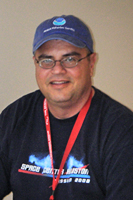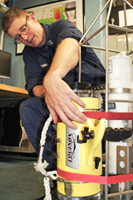
Throughout the Deepwater Horizon crisis, NOAA personnel from across the agency worked to conduct science, keep seafood safe, assess damage, protect wildlife, and restore habitat. They worked in the air, on the water, on the ground and in sensitive wetlands to combat the spill. Our people continue to work to determine the total environmental and economic impact of the spill and the efforts needed to restore the Gulf Coast.
Meet just some of the NOAA people involved in the response:

DENNIS APETI
Physical Scientist
NOAA’s National Centers for Coastal Ocean Science
Dennis Apeti, an expert in pollution and contaminant assessment, sailed aboard NOAA Ship Thomas Jefferson, lending his expertise with nearshore environments to assist in the search for subsurface oil. While onboard, he participated in an effort to collect samples for water quality assessment and to determine whether polyaromatic hydrocarbons (PAH) and volatile organic compounds (VOC), which could indicate the presence of subsurface oil, were present.
TIM ERICKSON
Emergency Response Meteorologist
NOAA’s New Orleans/Baton Rouge Weather Forecast Office
When weather and seas got rough, the Deepwater Horizon response team turned to Tim Erickson and the meteorologists in the National Weather Service’s New Orleans/Baton Rouge forecast office. He was dispatched to the Incident Command Post in Houma, La., to serve as the on-site emergency response meteorologist for the effort, providing forecasts to ensure safety of the responders as they worked in the air, on the water, and on the ground to contain the oil slick.
JOHN FORET
Research Fishery Biologist
NOAA’s Southeast Fishery Science Center
John Foret has been the federal manager for many projects focused on the creation and restoration of sustainable estuarine habitats. For the Deepwater Horizon oil spill response, he held an active leadership role at the Unified Command joint command center in Houma, La. His efforts were essential to keeping information flowing between the field command centers, NOAA headquarters and the broader spill response community.
SEUMAS GAGNE
Web Developer
NOAA’s Office of Response and Restoration
Seumas Gagne is a NOAA webmaster who develops and supports custom applications and assists the needs of oil spill responders. For the Deepwater Horizon incident, his work remained much the same, but required far greater direct involvement in content updating and troubleshooting. Because of the constantly changing nature of the spill response, he remained available to update the public pages with status reports, trajectory maps, and other publicly-oriented content at all hours of the day and night.
LT SAM GREENAWAY
Ocean Engineer and NOAA Corps Commissioned Officer
NOAA’s Office of Response and Restoration
LT Sam Greenaway is an Officer in the NOAA Corps, one of the seven uniformed services of the United States. He is currently pursuing a Masters of Science in Ocean Engineering at the University of New Hampshire. During the Deepwater Horizon incident, he logged several weeks at sea aboard NOAA ships, applying his research to try to determine if acoustics can be helpful in characterizing the extent of subsurface oil in a particular area.
MICHAEL GREER
Field Information Manager
NOAA’s Office of Response and Restoration
Michael Greer served as a field information manager with the Gulf Coast oil spill response, focusing on information management and GIS analysis for data collected from aircraft overflights. He processed the aerial photos and data with GIS software to produce updated trajectory maps that visually tracked the movement of the spill. He also helped manage the intense data flow generated by the response.
DOUG HELTON
Incident Operations Coordinator
NOAA’s Office of Response and Restoration
During oil and chemical spills, Doug Helton helps manage a "war room" located at NOAA's Office of Response and Restoration western regional office in Seattle. Although far from the Deepwater Horizon site, he worked to coordinate the influx of scientific information and generate the science products needed to guide the response.
CHARLIE HENRY
Scientific Support Coordinator
NOAA’s Office of Response and Restoration
Charlie Henry is a first responder to oil and chemical spills for Texas, Louisiana, Mississippi, Alabama, and the Florida Panhandle. As lead scientific support coordinator for the Deepwater Horizon incident, he was responsible for managing a team of physical scientists, marine biologists, chemists and others conducting field observations, tracking the movement of oil, understanding resources at risk and determining environmental tradeoffs of countermeasures and cleanup methods.
BLAIR MASE
Marine Mammal Stranding Coordinator
NOAA’s Southeast Fishery Science Center
Blair Mase develops stranding program policies and guidance in coordination with a vast network of state, federal and international agencies, including direct contacts with the U.S. Navy, U.S. Coast Guard, National Park Service and others. She mobilized the regional network of marine mammal stranding responders, ensuring they were adequately trained and following the appropriate protocols for dealing with any marine mammals affected by the oil spill.
ANDREW MASON
Physical Scientist
NOAA’s National Centers for Coastal Ocean Science
Andrew Mason, a physical scientist, spent time in the vicinity of the Deepwater Horizon wellhead aboard R/V Ocean Veritas taking water samples and assessing the physical characteristics of the water column in the area. He also spent a week on NOAA Ship Thomas Jefferson assisting with collecting samples, interpreting data and mission planning.
KEITH MULLIN
Marine Mammal Program Manager
NOAA’s Southeast Fishery Science Center
Keith Mullin is a Mississippi-based marine mammal expert who coordinated marine mammal assessment activities during the Deepwater Horizon oil spill. He conducted aerial surveys of the northern Gulf of Mexico to search for marine mammals, sea turtles and other large marine animals to assess the impact of the spill on those resources.
DEBBIE PAYTON
Physical Scientist
NOAA’s Office of Response and Restoration
Debbie Payton is a modeler for NOAA's Office of Response and Restoration, specializing in forecasting efforts to determine the movement of oil amidst tides, currents, winds and weather. In addition to providing this support during the Deepwater Horizon incident, she also served as chief scientist for the Unified Command's subsurface monitoring unit studying oil beneath the surface.
Read more about Debbie in an “Ask a Responder” piece on RestoreTheGulf.gov.
NICKIE SCILLO
Information Technology Specialist
NOAA’s Office of Response and Restoration
Nicole (Nickie) Scillo was one of the “go-to” persons for information management support for oil spill responses. She was deployed to Houma, La., within a few days of the Gulf Coast oil spill to consult her on every imaginable IT-related need. She was part of the team that created ResponseLINK (https://responselink.orr.noaa.gov), an innovative Web-based system for sharing information within the response team during oil and hazardous material spills.
LTJG JOSHUA SLATER
Ocean Engineer and NOAA Corps Commissioned Officer
NOAA’s Office of Response and Restoration
LTJG Joshua Slater is an Officer in the NOAA Corps, one of the seven uniformed services of the United States. He helped coordinate scientific support for the Deepwater Horizon oil spill. He worked on many issues associated with the crisis, including monitoring health and safety issues for field responders and ensuring the accuracy of NOAA's internal oil spill crisis tools.
SAM WALKER
Oceanographer
NOAA’s Integrated Ocean Observing System
Sam Walker, a senior technical data manager with NOAA’s Integrated Ocean Observing System, lent his time and strategic planning skills to support the Deepwater Horizon incident since the early days of the crisis. He also served as chief scientist on a united team of federal and academic personnel searching for concentrations of oil beneath the surface of the water.
Read more about Sam in an “Ask a Responder” piece on RestoreTheGulf.gov.















